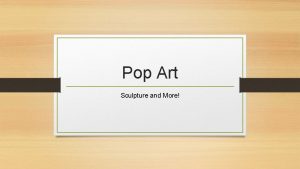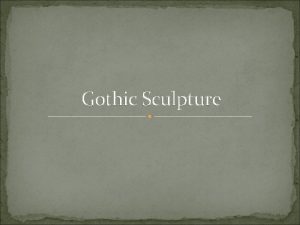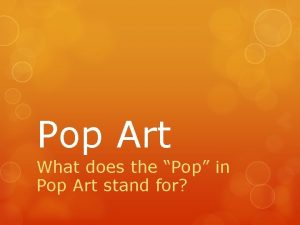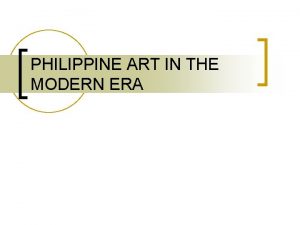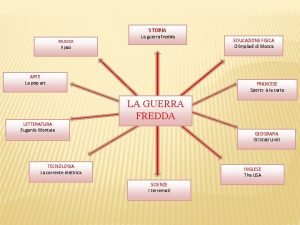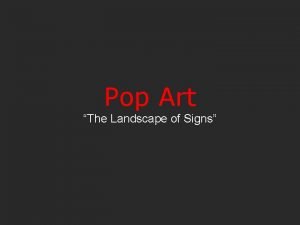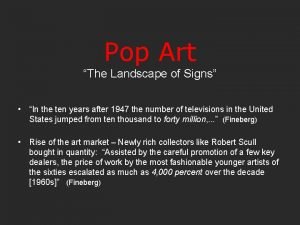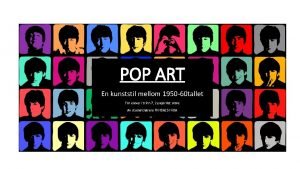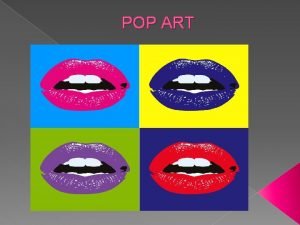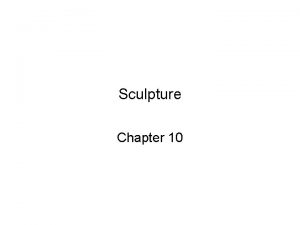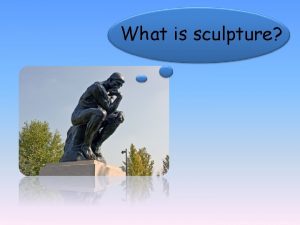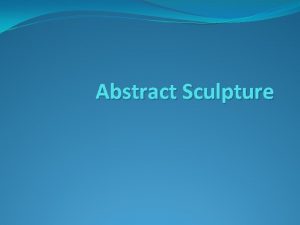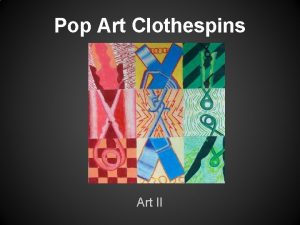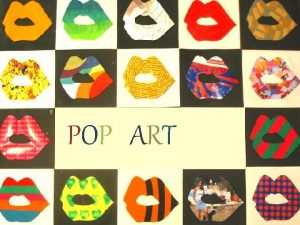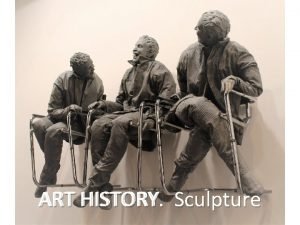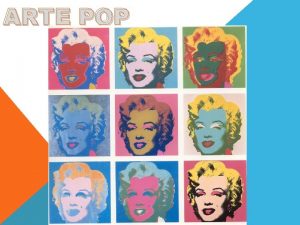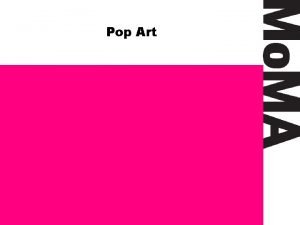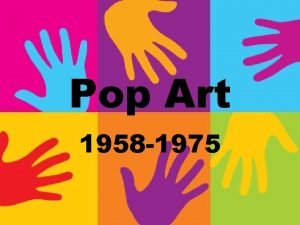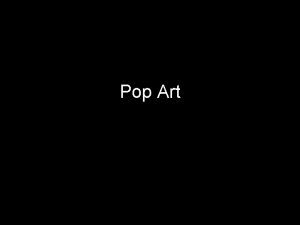Pop Art Sculpture and More What is Pop























- Slides: 23

Pop Art Sculpture and More!

What is Pop Art? • Art based on modern popular culture and the mass media, especially as a critical or ironic comment on traditional fine art values. • The term Pop-Art was invented by British curator Lawrence Alloway in 1955, to describe a new form of "Popular" art - a movement characterized by the imagery of consumerism and popular culture. • Common sources of Pop iconography were advertisements, consumer product packaging, photos of film-stars, pop-stars and other celebrities, and comic strips.

What is consumerism? • Doctrine that ever-increasing consumption of goods and services forms the basis of a sound economy. • Continual expansion of one's wants and needs for goods and services.

The Beginning • Pop-Art emerged in both New York and London during the mid 1950 s and became the dominant avant-garde style until the late 1960 s. • Characterized by bold, simple, everyday imagery, and vibrant block colors, it was interesting to look at and had a modern "hip" feel. • The bright color schemes also enabled this form of avant-garde art to emphasize certain elements in contemporary culture, and helped to narrow the divide between the commercial arts and the fine arts.

The Beginning • British Pop-Art emerged from within the Independent Group - an informal circle of artists including painter Richard Hamilton, curator and art critic Lawrence Alloway, and sculptor Eduardo Paolozzi, that met in the Institute of Contemporary Arts in London. • From the first meeting, in 1952, their discussions centered largely around the artistic value and relevance of popular mass culture.

Famous American Pop Artists • Jim Dine, Robert Indiana, Jasper Johns, Alex Katz, Roy Lichtenstein Claes Oldenburg, Robert Rauschenberg, James Rosenquist, Edward Ruscha, and Andy Warhol.

Andy Warhol • Warhol enjoyed a successful career as a commercial illustrator, before achieving worldwide fame for his pop-style painting, screen-prints, avant-garde films, and a lifestyle involving a mixture of Hollywood stars, intellectuals, avant-garde artists and underground celebrities. • During the 1960 s, he started producing paintings of iconic American products, like Campbell's Soup Cans, Coca-Cola bottles and dollar bills, together with images of international stars such as Marilyn Monroe, Ingrid Bergman, Elizabeth Taylor and Elvis Presley. • Above all, Warhol's art revolved around iconography made famous through TV, news film-clips and advertising, such as atomic bomb mushroom clouds, penitentiary electric chairs, car crashes and race riots. • His pictures were therefore instantly recognizable and generated mass appeal. • He was exceptionally prolific, working across a wide range of media, including drawing, painting, printmaking, photography, and films.

Roy Lichtenstein • His works turned comic-strip graphics into an international art form. • Beginning as an abstract artist in the 1950 s, a teaching post at Rutgers University brought him into contact with fellow-teacher Allan Kaprow, and triggered his involvement in pop-culture art. • He began by painting free-hand versions of comic-strip frames, complete with text bubbles (eg. "Look Mickey", 1961), and had a sell-out show at the New York gallery of Leo Castelli, in 1961. • The following year his works appeared in both major 1962 exhibitions in Pasadena and New York. • Iconic works of the time included: "Drowning Girl" (1963), and "Whaam!" (1963). In 1989, at Christies sale of contemporary art in New York, Lichtenstein's painting "Torpedo. . . Los!" sold for $5. 5 million - a record for the artist.

Jasper Johns • Johns was an early pioneer of Pop-art during the 1950 s. • Moving from South Carolina to New York in 1949, he first became known for his paintings featuring the American flag (eg. "Flag", 1954 -55), as well as other standard graphical images like targets and numbers. • After his flag pictures, he began to incorporate real objects into his paintings and also took up sculpture (eg. "Ale Cans", 1964). • More of a classical, painterly artist than many other younger practitioners of Pop who relied on techniques of modern commercial art, Johns' intelligent and innovative works attracted much praise and patronage. • In 1998, the Metropolitan Museum of Art in New York reportedly paid $20 million for his work "White Flag", while in 2006, his work "False Start" was bought by private collectors for a reputed $80 million, making it the most expensive painting by a living artist.

Claes Oldenburg • Regarded as the major Pop-art sculptor • Renowned for his public art installations • often featuring monumental replicas of everyday objects, especially foodstuffs like burgers and ice-cream cones. • Active in New York from 1956, Oldenburg came into contact with Allan Kaprow, Jim Dine, and the sculptor George Segal, and became taken up with Happenings, and other forms of Performance and Installation art. • Noted works included: "Dual Hamburger" (1962), as well as his giant lipstick erected at Yale University in 1969. • His main contribution to Pop Art was to turn commonplace objects into art.

What difference did Pop Art make in the world? • Pop art was instrumental in opening up the world of painting and sculpture to ordinary people who, perhaps for the first time in their lives, could instantly recognize and appreciate the exhibit in front of them. • They might not like it, but they were far less likely to feel intimidated by an everyday image they could relate to. • In this sense, Pop-art made museums and galleries more relevant to the general public.

Highlights • If nothing else, Pop-art was the post-war expression of a world wholly preoccupied with the pursuit of materialism. • Emerged in the 1950’s within the Independent Group, and lasted into the late 1960’s. • Pop Art uses familiar images to attract it’s viewers, and make the work seem more relatable. • Satire, Consumerism, Mass Production, and Pop Culture all main themes in Pop Art works.

Claes Oldenburg

Bio • Born January 28, 1929 in Stockholm, Sweden • American sculptor, best known for his public art installations typically featuring very large replicas of everyday objects. • Many of his works were made in collaboration with his wife, Coosje van Bruggen, who died in 2009 after 32 years of marriage. • Oldenburg lives and works in New York. Yale University, graduated in 1951 • Art Institute of Chicago from 1952 to 1954.

• Whimsical sculpture of pop culture objects is the signature work of this Swedish American artist. • His father was a diplomat and moved his family during Claes' childhood • New York State; Oslo, Norway; and Chicago Illinois • Claes did not become an American citizen until 1950. • In 1956, he moved to New York where he drew and painted while working as a clerk in the art libraries of Cooper-Union. • He became interested in environmental art through Allan Kaprow. • 1959, had his first one-man show, held at the Judson Gallery, New York- where he exhibited wood and newspaper sculpture and painted papiermache objects.

The Store

In 1960, he created his first Pop-Art environments and Happenings in a mock store full of plaster objects.

• The Store was one of the all-time great Pop Art installations, more subversive even than Andy Warhol’s breakthrough exhibition of 32 Campbell’s Soup cans in 1962. • Oldenburg’s store was actually situated in the realm of five-and-dime commerce. • Oldenburg’s store presented the question as a streetside experiment. Anyone who walked in became part of the conversation – often without even knowing it.

Some of Claes Oldernburg’s most famous works

Claes Oldenburg, Giant BLT (Bacon, Lettuce, and Tomato Sandwich), 1963. Vinyl, kapok fibers, painted wood, and wood, 32 × 39 × 29 in. (81. 3 × 99. 1 × 73. 7 cm). Whitney Museum of American Art, New York; gift of The American Contemporary Art Foundation

Apple Core, 1992 Stainless steel, urethane foam, resin, urethane enamel, 300 x 200 cm Gift of the Morton and Barbara Mandel Fund, Mandel Associated Foundations, Cleveland, to American Friends of the Israel Museum

Spoonbridge and Cherry, 1988 Stainless steel and aluminum painted with polyurethane enamel 29 ft. 6 in. x 51 ft. 6 in. x 13 ft. 6 in. (9 x 15. 7 x 4. 1 m) Minneapolis Sculpture Garden, Walker Art Center, Minneapolis, Minnesota

Dropped Cone Neumarkt Galerie, Cologne, Germany Stainless and galvanized steels, fiberreinforced plastic, balsa wood; painted with polyester gelcoat 39 ft. 10 in. (12. 1 m) high x 19 ft. (5. 8 m) diameter; height above building: 32 ft. 10 in. (10 m) Commissioned by Neumarkt Galerie
 More more more i want more more more more we praise you
More more more i want more more more more we praise you More more more i want more more more more we praise you
More more more i want more more more more we praise you Pop art sculpture
Pop art sculpture Romanesque and gothic sculpture
Romanesque and gothic sculpture What does pop in pop art stand for
What does pop in pop art stand for Philippine art sculpture
Philippine art sculpture New british sculpture
New british sculpture Human history becomes more and more a race
Human history becomes more and more a race 5 apples in a basket riddle
5 apples in a basket riddle The more you study the more you learn
The more you study the more you learn Aspire not to
Aspire not to Examples of newton's first law
Examples of newton's first law Knowing more remembering more
Knowing more remembering more More love to thee o lord
More love to thee o lord More choices more chances
More choices more chances Workshop pop art
Workshop pop art Montale guerra fredda
Montale guerra fredda Pop art illustrator
Pop art illustrator Pop art landscape
Pop art landscape Exhibition
Exhibition Pop
Pop Hva er popkunst
Hva er popkunst Expresionismo y pop art
Expresionismo y pop art 1960 pop art
1960 pop art


